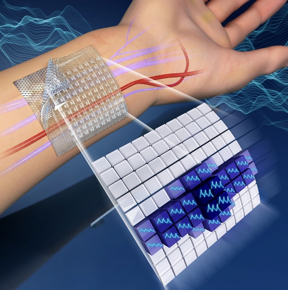Home > Press > Measuring pulse waves with a hair-thin patch
 |
| Pulse signal map created by ultrathin wearable sensors with 100 sensing pixels.
CREDIT POSTECH |
Abstract:
A pulse wave is a wave in which the blood flow that originates from the heartbeat is transmitted to the body. It is an important biosignal that indicates cardiovascular health. Analyzing the pulse wave signal can diagnose cardiac conditions including high blood pressure, arteriosclerosis and more. However, conventional pulse wave measuring devices are cumbersome as they require wearing the blood-pressure measuring cuff or stiff tong-shaped sensor and can mostly be performed at hospitals.
Measuring pulse waves with a hair-thin patch
Pohang, South Korea | Posted on March 4th, 2022
Recently, a POSTECH research team led by Professor Sungjune Jung (Department of Convergence IT Engineering and Department of Materials Science and Engineering), Dr. Sanghoon Baek (Department of Convergence IT Engineering), and Professor Sung-Min Park (Department of Convergence IT Engineering, Department of Mechanical Engineering, and Department of Electrical Engineering) in collaboration with Professor Hyunhyub Ko of UNIST (School of Energy and Chemical Engineering) has developed a wearable sensor patch thinner than a hair strand that can measure pulse wave signals with high precision.
What is notable about this research is that the patch was printed using inkjet printing that we are familiar with. This printing technology is also well known as a next-generation semiconductor manufacturing method that can dramatically reduce cost. Using this technology, wearable electronic devices can be made by simply printing conductive ink on a very thin substrate.
First, the research team fabricated a pressure sensor that mimics skins tactility and used it to enable physical pulse waves to be detected by the patch just as they are detected by the fingers. The researchers also used a patch-type device with 100 sensor pixels to obtain a two-dimensional (2D) pressure map on the wrist. Conventional wearable pulse wave sensors are designed to measure signals only at a single location, making it difficult to accurately place them on the artery, leading to less precise measurements.
Through experiments, the researchers successfully created a 2D pressure map to accurately obtain the pulse wave signals and analyzed their strengths to locate the invisible arterial blood vessels. Moreover, the researchers developed sensor patches of various sizes by taking age, gender, and body sizes into consideration. Such personalized design was possible by the simple inkjet printing technology.
This study is significant in that it has demonstrated possible applications of inkjet printing to next-generation customizable wearable devices, remarked Professor Sungjune Jung of POSTECH.
The newly developed technology allows for at-home diagnosis of diseases that are usually performed only at hospitals, explained Professor Sung-Min Park of POSTECH. He added, it can be used for medical applications such as pre-diagnosis of cardiovascular diseases and arterial catheter injections in daily life.
Recently published in the international journal ACS Nano, this study was conducted with the support from the Technology Innovation Program funded by the Ministry of Trade, Industry & Energy of Korea (MOTIE) and from the LG Display-POSTECH Incubation program.
####
For more information, please click here
Contacts:
Jinyoung Huh
Pohang University of Science & Technology (POSTECH)
Office: 82-54-279-2415
Copyright © Pohang University of Science & Technology (POSTECH)
If you have a comment, please Contact us.
Issuers of news releases, not 7th Wave, Inc. or Nanotechnology Now, are solely responsible for the accuracy of the content.
News and information
![]()
Atom by atom: building precise smaller nanoparticles with templates March 4th, 2022
![]()
Visualizing the invisible: New fluorescent DNA label reveals nanoscopic cancer features March 4th, 2022
Govt.-Legislation/Regulation/Funding/Policy
![]()
Visualizing the invisible: New fluorescent DNA label reveals nanoscopic cancer features March 4th, 2022
![]()
A new platform for customizable quantum devices February 25th, 2022
![]()
Entanglement unlocks scaling for quantum machine learning: New No-Free-Lunch theorem for quantum neural networks gives hope for quantum speedup February 25th, 2022
![]()
Cutting through the noise: Berkeley Lab error mitigation approach helps quantum computers level up February 25th, 2022
Possible Futures
![]()
Superb switching uniformity of RRAM with localized nanofilaments of wafer-scale Si subulate array March 4th, 2022
Nanomedicine
![]()
Visualizing the invisible: New fluorescent DNA label reveals nanoscopic cancer features March 4th, 2022
![]()
Breaking the black box of catalytic reactions: Research offers new understanding of complex catalysis, advances catalyst design February 25th, 2022
![]()
Shape memory in hierarchical networks the astonishing property that allows manipulation of morphing materials with micro scale resolutions February 25th, 2022
Discoveries
![]()
Atom by atom: building precise smaller nanoparticles with templates March 4th, 2022
![]()
Visualizing the invisible: New fluorescent DNA label reveals nanoscopic cancer features March 4th, 2022
Announcements
![]()
Atom by atom: building precise smaller nanoparticles with templates March 4th, 2022
![]()
Visualizing the invisible: New fluorescent DNA label reveals nanoscopic cancer features March 4th, 2022
Interviews/Book Reviews/Essays/Reports/Podcasts/Journals/White papers/Posters
![]()
Superb switching uniformity of RRAM with localized nanofilaments of wafer-scale Si subulate array March 4th, 2022
Nanobiotechnology
![]()
Atom by atom: building precise smaller nanoparticles with templates March 4th, 2022
![]()
Visualizing the invisible: New fluorescent DNA label reveals nanoscopic cancer features March 4th, 2022










